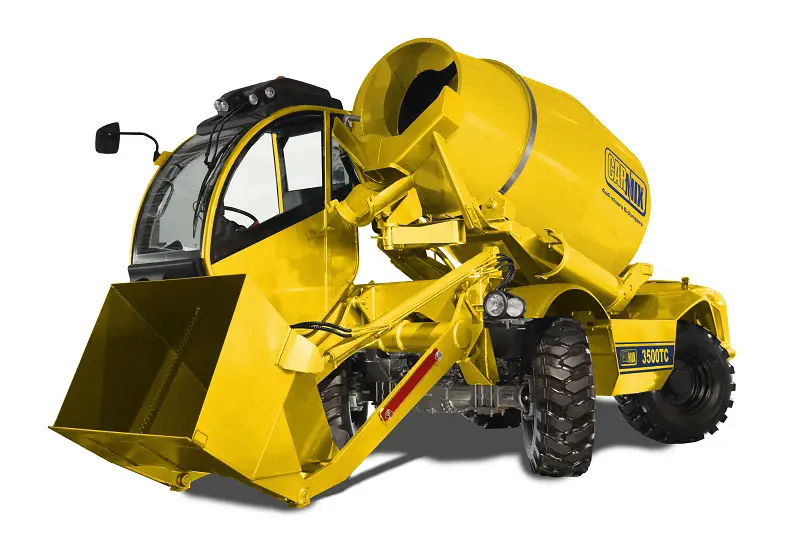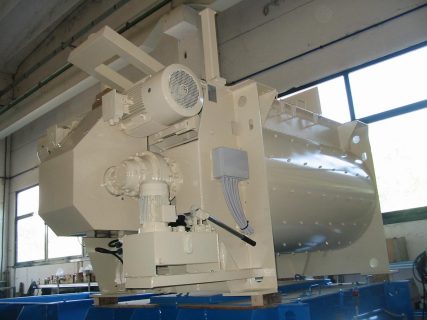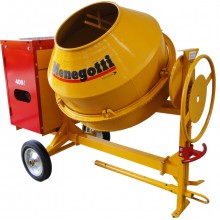Many contractors always find it advantageous to have their own concrete mixer as opposed to depending on outside vendors and if you are a new entrant to the construction industry it is an investment worth making. While weighing on whether to call on ready-mix concrete delivery or owning your own mixers, many factors should be weighed. These include among others, job scope, the location of the site, size and quality of staff and the time frame attached to the project.
For instance, it is counterproductive for a contractor to use a portable concrete mixer when he needs to pour a slab of 50 square metres. He is much better served using ready-mix. Similarly, if a job needs to be completed in an hour so contractors can move on to the next job, ready-mix is a smarter choice. Nevertheless, according to Stefano Tognoloni of Concrete Mixers s.r.l in Italy, your mixer of choice should ensure very high reliability, independence, and flexibility in working time.
In-transit Mixers
In-transit mixers are made to transport and mix concrete up to the construction site. They can be charged with dry materials and water, with the mixing occurring during transport. They can also be loaded from a ‘central mix’ plant, with this process the material has already been mixed prior to loading. The concrete mixing transport truck maintains the material’s liquid state through agitation, or turning of the drum, until delivery.
The interior of the drum on a concrete mixing truck is fitted with a spiral blade. In one rotational direction, the concrete is pushed deeper into the drum. This is the direction the drum is rotated while the concrete is being transported to the building site. This is known as ‘charging’ the mixer. When the drum rotates in the other direction, the Archimedes’ screw-type arrangement ‘discharges’ the concrete out of the drum. From there it may go onto chutes to guide the viscous concrete directly to the job site.
If the truck cannot get close enough to the site to use the chutes, the concrete may be discharged into a concrete pump, connected to a flexible hose, or onto a conveyor belt which can be extended some distance (normally ten or more metres). A pump provides the means to move the material to precise locations, multi-floor buildings, and other distance prohibitive locations. Buckets suspended from cranes are also used to place the concrete. The drum is traditionally made of steel but on some newer trucks as a weight reduction measure, fibreglass has been used.
Advantages
The biggest advantage of transit mixers is that these do not allow segregation of concrete because of continuous rotation. Unloading of concrete batch can be done at will in full or partially.
According to Brett Fillmore of ProAll Reimer Mixers in Canada, modern job site characteristics cause great challenges for traditional concrete delivery methods. However, having a concrete mixer onsite means concrete is mixed fresh no matter where you are. There is no wait time, and materials are mixed only when you need them.
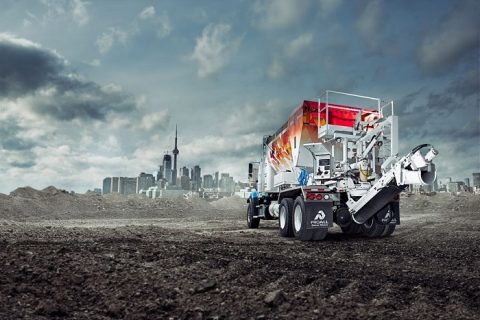
Drum of concrete mixer does not allow any foreign material to enter the concrete load. Concrete can be unloaded to a conveyor belt, a concrete pump or into the chutes. As the capacity of available transit mixers varies from 4 cubic metres to 12 cubic metres, choice is available as per site requirements and concrete production rate.
More advantages include: vast improvement in the quality and uniformity of concrete and enhanced speed of construction; savings in labour, reduction in wastage, elimination of material procurement requirements and storage hassles; plus the environmental conservation aspect whereby the surroundings of the site remain clean.
According to Manuela Galante the Marketing Director at Carmix, the in-transit mixers have the ability to mix, transport and deliver any kind of concrete directly in the jobsite, in any condition of work, latitude and clime, allowing the user to control the cost and the quality of each single cubic meter of concrete.
Portable Mixers
The smaller models which are normally available in sizes ranging from 3 to 12 cubic feet; will fit in the trunk of most cars, while the larger capacity units can be towed easily on wheels or hoisted onto a truck for longer distances. With their small size and easy portability they can be used even in remote areas that characterize most African settings. To a budding contractor wishing to establish himself but facing financial constraints, this could be a perfect start up as their costs are quite accommodative.
Advantages
The biggest advantage in owning a portable mixer is realized when working on sidewalks, foundations and binding block, and when preparing mortar bases. Many decorative concrete contractors find the portable mixers ideal too. A good example is the monument works industry which mostly has mixers mounted on their own trucks. The same holds true for many landscape and fence builders.
One interesting model of portable mixers is the wheelbarrow-style mixer that fits comfortably through a 30-inch-wide opening. This allows the user to mix and pour right where the product is needed.
On the other hand contractors working in a back yard or space-restricted area where accessibility is a problem will find a portable mixer much more effective. Smaller mixers are highly recommended for mixing concrete to anchor fence posts; for patching; for small concrete slabs on grade; and for mixing non-stick grout.
For high-production jobs such as concrete slabs, sidewalks and block walls, larger-capacity models are better suited. There are many styles and sizes to choose from, from a 2-cubic-foot pedestal style to a 31⁄2-cubic-foot wheelbarrow style to a 9-cubic-foot towable unit. The utility mixers start at 11⁄2 cubic feet and can be mounted or be made stationary; or an optional low- or high-speed tow kit can be added.
The mixers come with either electric- or gasoline-powered sources. Single-phase electric motors are available in the 1⁄2- to 11⁄2-horsepower range while gas engines span from 3 to 13 horsepower. Mixers also have speed controls that can be adjusted to fit the requirements of the specific job.
According to Pooja Pandya of Engineering Supplies Limited, drum capacity; cycles per hour, mixer build quality, life of the product and availability of sales and service are very important factors to consider when a contractor is looking for a portable concrete mixer.
Engineering Supplies offers a wide range of concrete mixers for the East African market. “Our products are quite unique in the market, some of the unique aspects include: the 6 ring segment that makes repairs more cost friendly and ensure a longer life to the mixers and the rental model which is used regularly by rental companies, proving its strength and durability,” she said. “The products are designed in such a way that there is a balance between price and quality,” she affirmed.
Most manufacturers offer steel and polyethylene drums to fit individual user preferences. Steel drums are more durable, but cleaning can often be tedious and other damage to the drum is a possibility. Poly drums, which resist rust, can be cleaned in minutes by simply tapping with a rubber mallet and they are lighter than their steel counterpart.
According to Pooja Pandya of Engineering Supplies Limited, drum capacity; cycles per hour, mixer build quality, life of the product and availability of sales and service are very important factors to consider when a contractor is looking for a concrete mixer.
Engineering Supplies offers a wide range of concrete mixers for the East African market. “Our products are quite unique in the market, some of the unique aspects include: the 6 ring segment that makes repairs more cost friendly and ensure a longer life to the mixers and the rental model which is used regularly by rental companies, proving its strength and durability,” she said. “The products are designed in such a way that there is a balance between price and quality,” she affirmed.
Most manufacturers offer steel and polyethylene drums to fit individual user preferences. Steel drums are more durable, but cleaning can often be tedious and other damage to the drum is a possibility. Poly drums, which resist rust, can be cleaned in minutes by simply tapping with a rubber mallet and they are lighter than their steel counterpart.
Choosing you mixer
The nature and volume of work is a factor to consider in choosing the right mixer. Big-scale construction projects require bulk concrete mixers which can mix large quantities of concrete both onsite and offsite. For small scale projects, smaller mixers can apply. The size of construction site is a major factor to consider. Remember smaller mixers can fit well in squeezed sites while large open sites can comfortably accommodate the bigger ones.
Mr. Bodino Mattia from Merlo in Italy mentions that, you have to make sure the concrete mixer will have a good cycle time, which will impact on its concrete output and also good maneuverability.
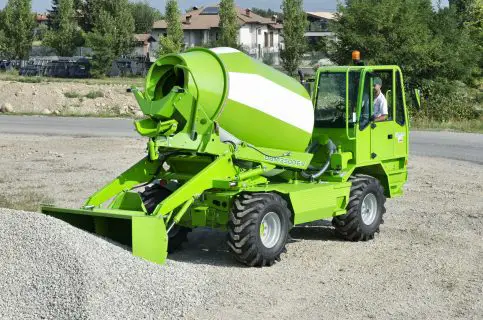
“This combined with the robustness and reliability of the machine will lead to cost-efficiency in the long run,” mentions Albert Vicens of AUSA in Spain.
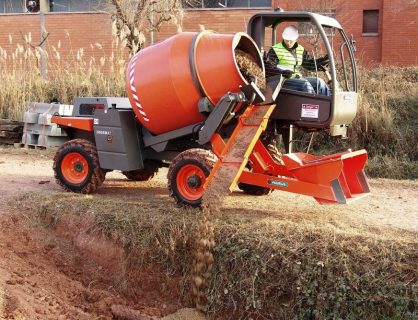
Moreover, Shama Barot of Safari Construction Equipment in India advises the customer to always compare the technical specifications against the cost. If they can work out a cost vs value analysis, in the long run they will realize that cheap low quality machines generate more loss for them than high quality high value construction machinery. “I have met many customers who have initially bought low quality machinery lured by the very low pricing, but eventually realizing greater losses on site due to downtime,” she affirms.
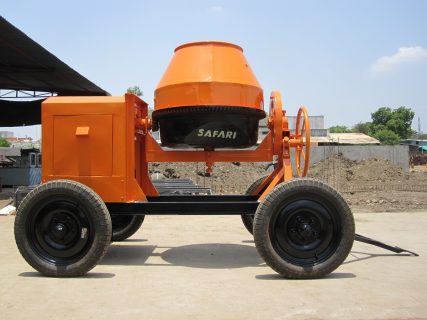
Safari Construction Equipment is a leading construction machinery manufacturer exporting world wide to more than 20 plus countries.
Maintaining your mixer
Normally the mixers are designed in such a way to help the operator to maintain the machine. According to Gladston of Esquire Machines, in India the greasing of the moving points are to be carried out on a daily basis. The diesel engine maintenance needs to be carried out as per manufacturer’s recommendation. If provided with a hydraulic system, adequate care should be taken to ensure the system is clean and free from leakages.
Per manufacturer recommendations, contractors should also check the oil levels and filters of portable mixers daily. In using the mixer, the mixer V-belt and pulleys should be tight while the necessary parts should be greased frequently. Gears on a concrete mixer, however, should never be greased. Debris, sand, sediment or other material can become trapped in the gears, causing major damage to the unit. Simple cleaning and lubrication will help keep the mixer running trouble-free for years to come.

